A Novel Niche Quantum Ant Colony-Based Clustering Optimization Approach for Wireless Auto Meter Reading Network
Abstract
Since the low cost and high flexibility, wireless automatic meter reading network (WAMRN) is widely used by utility companies to realize automatic collection and transmission of remote energy consumption information. Considering that WAMRN is composed of several wireless communication nodes, the lifetime of the network will be affected by factors such as the changeable deployment environment and the limited energy of nodes. Thus, a novel niche quantum ant colony-based WAMRN clustering optimization method is proposed in this paper to address the problem of how to make full use of the limited energy to extend network lifetime and improve data transmission efficiency. In the proposed approach, a clustering model of WAMRN is defined; moreover, an improved Niche Quantum Ant Colony Optimization (NQACO) is proposed to optimize the model therefore to obtain an optimal clustering scheme, which can help WAMRN reduce unnecessary energy loss to achieve the purpose of extending the lifetime of the entire network. To verify the performance of the proposed method, NQACO is compared with some popular clustering methods, i.e., GA and SA, under different scenarios. The results show that under the premise of ensuring network communication, NQACO is superior to the other two methods in reducing the total energy consumption and prolonging the network lifetime.
1. Introduction
In the age of production automation, the realization of automatic meter reading (AMR) for water, electricity, and gas supplies has become an urgent problem for energy companies, for a reason that accurate and timely replication of water and electricity data will directly affect business decisions and economic benefits [1, 2]. By leveraging electronic, communication, computer, and network technologies to identify, read, process, and transmit meter data automatically, it enables the problems of single function, low accuracy, and undesirable real-time performance of traditional meter reading to be solved. Especially, the adoption of automatic meter reading technology not only improves the economic efficiency of enterprises but also enhances the degree of informatization [3]. Hence, there appears an inevitable trend of the application of automatic meter reading technology for water, electricity, and gas data reading.
At present, the technology of automatic meter reading consists of wired automatic meter reading and wireless automatic meter reading according to the mode of data transmission. Specifically, the former mainly makes use of power line networks, telephone line networks, RS-485 bus networks, etc. One disadvantage of the existing wired meter reading method lies in that it cannot be applied in a large scale and reliable way in the home meter reading system. It is because of its high cost, complex wiring, difficulty in commissioning and maintenance, susceptibility to the power grid, poor security, and poor scalability [4]. With the appearance of wireless automatic meter reading, it makes up for the deficiency of the wired automatic meter reading. The technologies used for wireless meter reading include GSM/GPRS, Bluetooth technology, and short-range wireless radio frequency transmission technology. Compared with traditional meter reading methods as well as wired methods, wireless meter reading can save labor costs, reduce wiring costs, and simplify the management to find problems and take corresponding measures promptly. To this end, WAMR has become a leading research direction of AMR.
In WAMRN, each energy meter node is powered by a battery with limited energy. In this way, to prolong the network lifetime as much as possible with energy limitation, researchers have conducted a lot of research on ways which can effectively enhance the energy utilization. Finding that the design of network topology and the selection of routing have a significant impact on the energy dissipation of nodes [5–7], researchers improve the energy utilization in WAMRN by designing a reasonable clustering model and using efficient optimization algorithm [8, 9]. Therefore, the focus of this paper is on the optimization of network clustering to effectively extend the lifetime of WAMRN.
In this paper, the most desirable nodes in the WAMRN are selected as cluster head nodes for clustering, such that the whole network is divided into several connected regions. In addition, the noncluster head nodes in each region are named member nodes, and the cluster head nodes manage the surrounding member nodes. In [10], the authors have shown that the optimal cluster head selection problem is an NP-hard problem. Therefore, we propose a Niche Quantum Ant Colony Optimization (NQACO) which combines the optimization mechanism of quantum evolutionary algorithms with the ant colony optimization. By using this approach, it can significantly enhance the search traversal and convergence speed when the problem size is large, while NQACO uses the niche technique to ensure the species diversity of the whole large ant colony. The existence of stable individual differences in the colony aids NQACO in overcoming the premature problem exhibited by other algorithms and allows for more desirable local search capabilities. In a nutshell, the proposed clustering approach can efficiently search for optimal routing clusters from the solution space, thus effectively decreasing the energy loss in WAMRN and thus extending the network lifecycle.
The structure of this thesis is just as below. In Section 2, the research work related to the clustering of sensor networks is introduced. Section 3 describes the entire network structure of WAMRN. Meanwhile, the corresponding mathematical model is designed and established. Section 4 proposes a new optimization algorithm to optimize the problem of clustering of WAMRN in Section 3. Section 5 shows the optimization performance of NQACO on the cluster routing model by comparing it with GA and SA. Finally, the whole work of this paper is summarized in Section 6.
2. Related Work
At present, there exist many kinds of AMR communication technologies. For instance, paper [11] applying radio frequency technology to AMR systems, which can help energy companies effectively reduce data collection costs and quickly collect key information to provide insights for decision-makers. Paper [12] realizes a wireless power monitoring system based on ZigBee technology monitoring power quality and remotely control power services. In addition, paper [13] uses the single-chip microcomputer STM32 to manage energy data and uses ZigBee for communicating between the electric energy meter and the data center. Afterwards, paper [14] designed a GPRS-based remote automatic meter reading wireless communication system hardware, which supports UDP communication protocol and can carry out remote data transmission through message transmission and network communication.
A lot of research results show that WSN is considered to be the key technology for building a new generation of smart grid AMR systems in the future [15–18]. However, since the energy supply of sensor nodes in WSN is battery-powered, the energy of the nodes has a certain limitation, and the energy of wireless sensor network nodes cannot be replenished at work. Therefore, considering extending the lifetime of the entire network as much as possible, it is an important design principle to improve the energy utilization rate and reduce the energy loss of the wireless sensor node in the construction of WSN. In paper [19], the researchers use the water meter as a node to form a wireless sensor network. That research focuses on making the energy consumption as small as possible by avoiding packets whose lengths exceed the length limit. The paper [20] points out that sensor nodes in WSN send their data to the central cluster head, which forwards the data to the desired receiver. Moreover, clustering can realize bandwidth reuse, thereby increasing system capacity.
To make up for the sustainability of QoS and bridge the gap between suboptimal solutions, the paper [21] proposed a quality-of-service routing algorithm based on genetic algorithm. That work solves the imbalance characteristic schematic diagram of QoS optimization in the ad hoc network and the previous convergence problem. However, the genetic algorithm used in this study has a specific dependence on selecting the initial population. In addition, the algorithm is prone to premature problems when solving large-scale computing problems.
In paper [22], the author proposed a lightweight dynamic TRUST model and bee mating algorithm for clustering. More specifically, to prevent malicious nodes from becoming cluster head nodes, they proposed a gradually reasonable priority scheme in the trust measurement. Nevertheless, since the amount of crossover operation information is small and the similarity of the bee colony is high in the process of optimizing the problem with the bee mating algorithm, it is prone to fall into the local optimum and seriously affect the performance of the algorithm.
Paper [23] proposes a modified clustering method based on LEACH (Low Energy Adaptive Clustering Hierarchy), which uses the Particle Swarm Optimization (PSO) algorithm to optimize the network clustering and determines cluster heads by considering factors such as energy, communication overhead, and load balance. Although the particle swarm algorithm used in the research has the characteristics of simple structure and fast search speed compared with other algorithms, it has some inescapable disadvantages such as low accuracy, easy divergence, and easy falling into local optimum. These shortcomings are in the process of clustering optimization, making the clustering undesirable.
In other perspectives, paper [24] proposes a clustering routing algorithm on the basis of chaotic binary ant colony optimization (CBACO) for wireless sensor networks. The algorithm calculates the energy consumption of the cluster head based on the remaining energy, the number of neighbors, and the distance to the base station (BS). In that paper, the routing process is divided into two steps, where the first step is to process the data transmission from the cluster head to the cluster head and the second one is to apply the biologically inspired optimization technology ant colony algorithm (ACO) to optimize the path finding process from the cluster head to the BS. Although the information interaction of ant colony algorithm is realized by pheromone, the convergence to the optimal solution is the process of information positive feedback. Positive feedback is designed to enhance the quality of the solution and achieve better performance. However, this algorithm will have the problem of evolutionary stagnation.
3. System Model
3.1. WAMRN Network Model
The structure of the WAMRN network model is shown in Figure 1. After the terminal collection node obtains the meter data, it transmits the data to the remote BS through the wireless communication node in WAMRN. To save energy, each wireless communication device can select an optimal path according to the actual situation and then transmit the data to the cluster head node through the optimal path for data integration. Without considering other factors, all wireless communication nodes have the same initial energy. Since each wireless communication device has the same data communication capability, the energy loss in the process of data transmission, fusion, and transmission is also the same. In WAMRN, the energy of the BS is not limited, and the BS is always in a normal working state. However, the wireless communication equipment in the network is restricted by its energy. If the energy is exhausted, the node will no longer work.
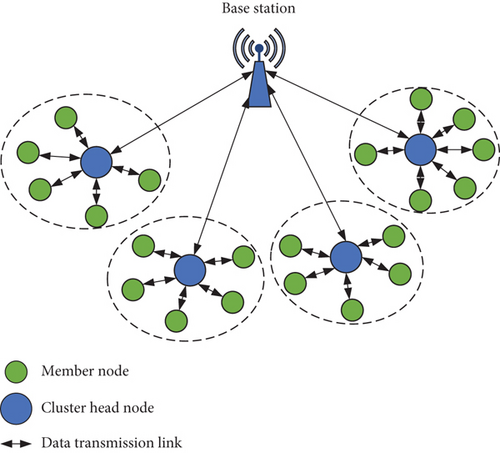
In common cases, the installation location of data collection and transmission wireless equipment depends on the actual situation. Therefore, the distribution of various meters is irregular. This situation can be understood as that each sensor device in WAMRN is randomly distributed.
3.2. Energy Loss Model of Wireless Communication Nodes
The wireless meter reading device in WAMRN belongs to one kind of the wireless communication device, so the energy consumption of the WAMRN can be calculated by using the energy consumption model of the wireless communication device. In fact, there is a lot of research work on the energy consumption of wireless terminals. Papers [25–27] put forward the theoretical explanation of content radio transmission and microcontroller processing. And in paper [28], the author proposes a first-order radio model, which models that the energy consumption of wireless terminals can widely describe the energy consumption in wireless terminals; it is used to calculate the energy consumption in many related research works. Therefore, this energy model is adopted in our research work.
The energy consumption of wireless communication nodes in WAMRN mainly includes three parts: sensing energy consumption, data communication energy consumption, and microprocessor energy consumption. Many current research results show that the energy consumption of wireless communication nodes in data communication accounts for more than 50% of the total energy consumption of WAMRN. Besides, the sensing energy consumption and microprocessor energy consumption are comparative fixed, so it is hard to reduce them through optimization. Therefore, this paper primarily analyzes the energy loss of each wireless communication node in WAMRN and studies a reasonable clustering method for achieving low energy consumption in the network.
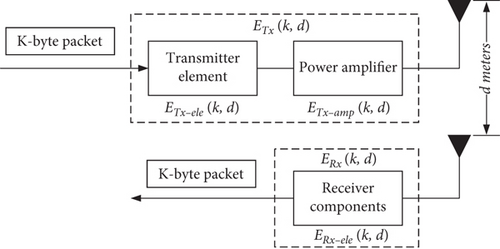
4. NQACO for Clustering Optimization in WAMRN
The proposed NQACO, based on quantum evolution and niche technology, is an improvement and upgrade of the traditional ant colony algorithm. It introduces the concept and theory of quantum computing, uses qubit coding to store information, and completes the update of quantum coding through quantum rotation gate. Meanwhile, the quantum evolution ensures that the performance of the algorithm will not be affected, and it can even significantly improve the convergence speed of the algorithm. Besides, to find an optimal solution in the whole solution space, NQACO use the niche mechanism to divide the ant colony into several niches. Due to the relative isolation between multiple niches, there is less gene exchange between different species, so there are some differences in species genes between these niches, which provides the species diversity of the whole ant colony. On the level of swarm intelligence optimization algorithm, stable individual differences facilitate NQACO to overcome the premature problem shown by other algorithms and can enhance the ability of local search.
The detailed procedures of using NQACO to solve the clustering optimization problem in WAMRN are as follows.
Step 1. Initialize NQACO with various parameters, including population size, the maximum number of iterations, pheromone trajectory strength, visibility parameters, pheromone volatility factor, number of wireless communication nodes in the network, and crowding factor.
Step 2. Quantum coding for ant colony according to Equation (7) and Equation (8) and initialization by chaotic mapping according to Equation (10) and Equation (11).
Step 3. Measure the qubit state according to Equation (9).
Step 4. Calculate the fitness value of each ant individual according to Equation (12)–Equation (16), and record the ant individual with the largest fitness value.
Step 5. Update pheromones according to pheromone strength and visibility using Equation (17) and Equation (18), and then, move the ants according to the transition probability calculated by formula Equation (19).
Step 6. Recalculate the fitness value of each individual ant, and record the individual with most significant fitness value.
Step 7. Use the optimal solution to update the direction of the quantum revolving gate, and then, update the quantum encoding ant through the quantum revolving gate by Equation (20).
Step 8. Randomly select ant individuals from the current population as crowded individuals. Then, calculate the correlation between other individuals in the ant colony according to Equation (21) and the excluded individual. Suppose the correlation between the excluded individual and another ant individual is greater than the average correlation between all individuals. Based on the exclusion mechanism, the individual with the lower fitness value of the two ants will be replaced by the individual with the higher fitness value.
Step 9. Judge whether the termination condition is reached, and output the optimal individual if it is reached, and use the binary code corresponding to this individual as the optimal clustering scheme for WAMRN. Otherwise, the algorithm will continue from Step 3 to the next iteration.
Figure 3 is the flow chart of NQACO.
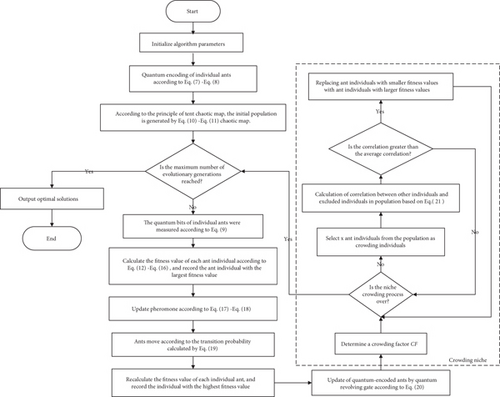
4.1. Quantum Coding and State Measurement
4.2. Initialization of Ant Population
In the process of population initialization, a random number x0 with a value range of [0,1] is given first. On this basis, tent mapping is used to generate n chaotic variables. Let the individual ants encode αn = sin(2πxn) and βn = cos(2πxn) in pi, so that the probability amplitude of each qubit in the information encoding carried by the initial ant will be evenly distributed in the solution space. By repeating the above operation popSize times, an initial population P = {p1, p2, p3, ⋯, ppopSize} with a population size of popSize can be obtained.
4.3. Construction of the Fitness Function
In this paper, the overall goal of optimizing the entire WAMRN is to minimize the entire network’s energy dissipation during data transmission to extend the network’s life as much as possible. Therefore, in the optimization process, the wireless communication nodes with higher residual energy, smaller communication distance within the cluster, and closer to the BS are more suitable to be selected as cluster heads.
4.4. Mobile Strategy and Positivity Update
4.5. Variation of Quantum Bits
| zl | Δθl | S(αlβl) | |||||
|---|---|---|---|---|---|---|---|
| αlβl > 0 | αlβl < 0 | βl = 0 | αl = 0 | ||||
| 1 | 0 | F | 0.001π | -1 | +1 | 0 | ±1 |
| 0 | 0 | F | 0 | 0 | 0 | 0 | 0 |
| 1 | 0 | T | 0.025π | +1 | -1 | ±1 | 0 |
| 0 | 0 | T | 0 | 0 | 0 | 0 | 0 |
| 1 | 1 | F | 0.005π | +1 | -1 | ±1 | 0 |
| 0 | 1 | F | 0.05π | +1 | -1 | ±1 | 0 |
| 1 | 1 | T | 0.025π | +1 | -1 | ±1 | 0 |
| 0 | 1 | T | 0.005π | -1 | +1 | 0 | ±1 |
In Table 1, represents the optimal cluster routing scheme generated by the previous generation, and T and F represent true and false in Boolean algebra, respectively.
4.6. Niche Based on Exclusion Mechanism
Assuming that the correlation between two individuals is higher than the average value of the correlation between individuals in the colony, based on the exclusion mechanism, the individual with the lower fitness value of the two ants will be replaced by the individual with the higher fitness value.
4.7. Termination Condition
If NQACO runs to the set maximum number of iterations, the clustering scheme carried by the individual with the best fitness value will be output. Otherwise, the iterative optimization is continued.
5. Simulation
To verify the optimization effectiveness of NQACO for the clustered routing problem in WAMRN, this paper compares NQACO with GA; SA under different conditions and through MATLAB simulations, total energy consumption generated during data transmission in the network is used as the evaluation metric. The WAMRN scenario simulated in this paper is static, and the concrete environmental parameters are shown in Table 2.
| Parameter | Value |
|---|---|
| k | 1000 bits |
| Eelec | 50 nJ/bit |
| εamp | 100 pJ/bit/m2 |
| εfs | 0.0013 pJ/(bit×m4) |
| EDf | 5 nJ/bit |
In the following simulation, the maximum number of iterations MAXGEN of the four algorithms for comparison is set to 100 rounds. Noting that different algorithms have different initial parameters, to ensure that these four algorithms can be in their respective optimal optimization states, the specific initial parameter settings of each algorithm are shown in Tables 3–5.
| Parameter | Value |
|---|---|
| Number of individuals | 80 |
| Pheromone track intensity | 2 |
| Visibility parameter | 2 |
| Pheromone volatilization coefficient | 0.9 |
| Parameter | Value |
|---|---|
| Number of individuals | 80 |
| Crossover probability | 0.7 |
| Mutation probability | 0.05 |
| Computing era | 0.9 |
| Parameter | Value |
|---|---|
| Starting temperature | 300 |
| Cooling factor | 0.95 |
| Maximum number of iterations | 100 |
In the simulation experiment of Figure 4, each algorithmic optimization process was repeated 50 times. The corresponding value in the line chart was the average value of 50 simulations.
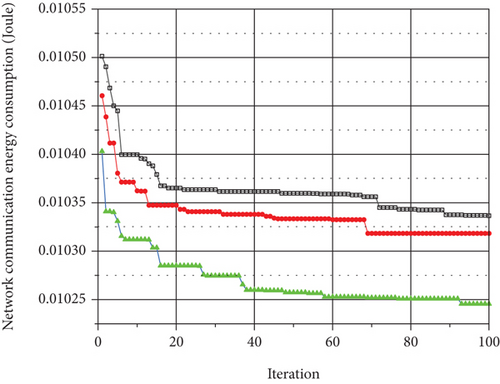
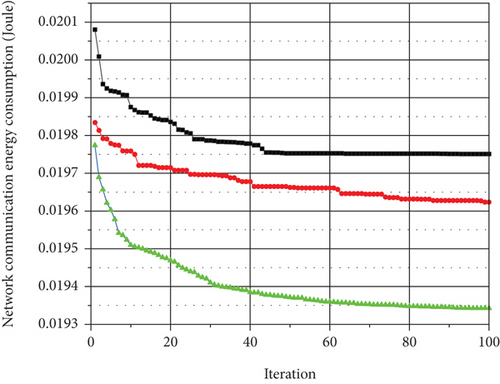
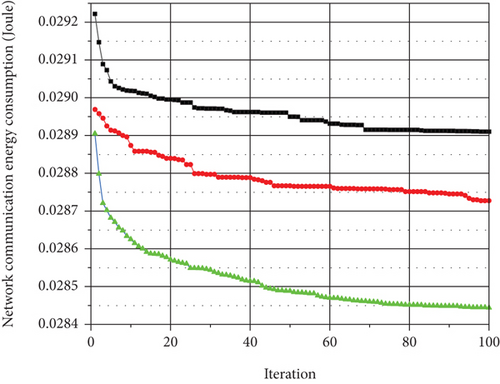
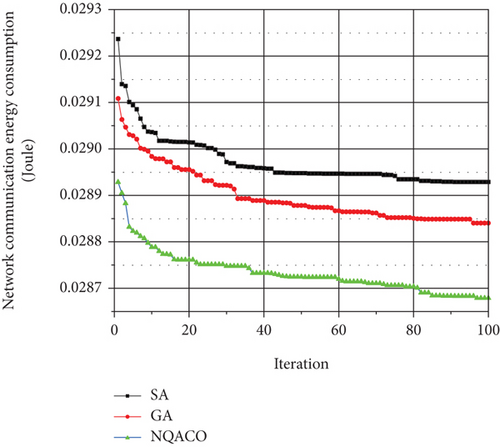
Figure 4 shows the optimization effect of these four algorithms on the total energy consumed of WAMRN when the network contains 100, 200, 300, and 400 wireless communication nodes, and the proportion of cluster heads in each final clustering scheme is 10%. From the trend of the curves in Figures 4(a)–4(d), although the total energy consumption of the three algorithms varies significantly during the first 60 iterations, the network optimized by NQACO is always lower than the GA and SA in terms of total energy consumption. In addition, the advantage of NQACO over the other two algorithms becomes more and more evident as the number of iterations increases.
Figure 5 shows the comparison between NQACO and the other two algorithms regarding the optimization of the network energy consumption for four cases of 5%, 10%, 15%, and 20% of the quantity of cluster heads in WAMRN with various wireless sensor sizes. In the simulations, each algorithm was run 100 times, and all calculation results were averaged over 50 Monte Carlo runs. From figure (a), it is clear that the total network energy consumption of the WAMRN optimized by NQACO is always less than that of SA and GA for different sizes of wireless sensor numbers. Meanwhile, when the number of wireless communication nodes in WAMRN increases, the overall network energy consumption also increases. The same conclusion can be easily drawn from figures (b), (c), and (d).
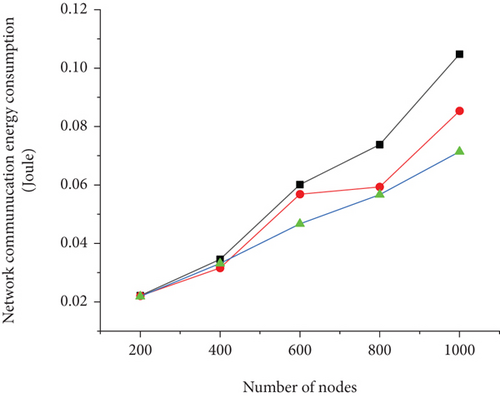
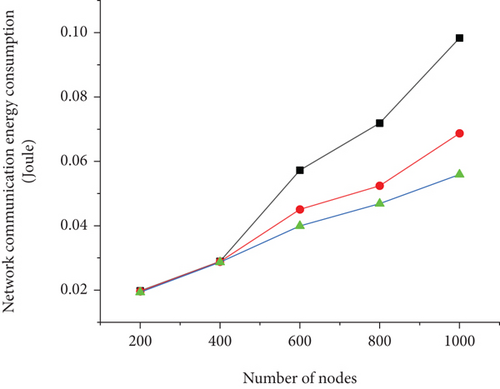
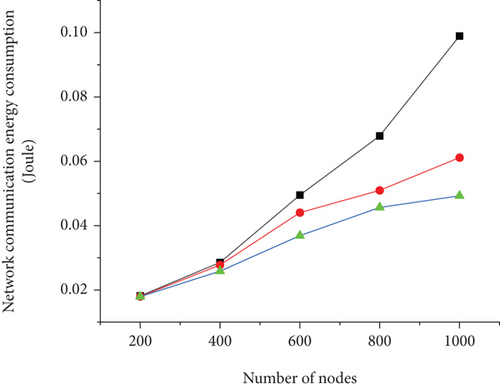
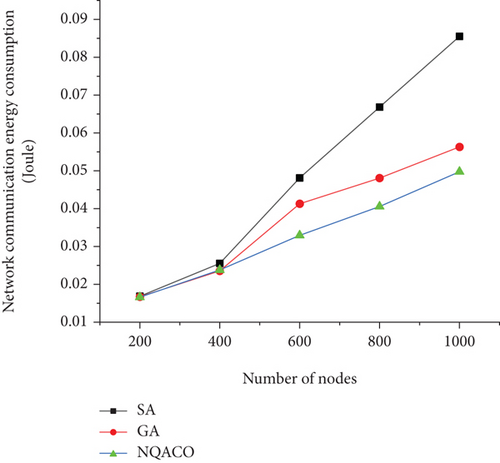
Figures 6 and 7 illustrate the relationship between surviving nodes’ quantity and round. During the experiment, the WAMRN contains 100 wireless communication nodes, and the initial energy of each wireless communication node is set to 0.5 J, and then, we record the number of surviving nodes in each round of data transmission and the remaining energy of each node. When a node runs out of energy, we remove it from the network so that the node cannot send or receive messages. Network lifetime is a key indicator of how well balanced the network’s energy consumption is. The longer the network lifecycle, the more balanced the network energy consumption, and the better the performance of the routing protocol is proven. Otherwise, the network energy consumption is unbalanced. From Figures 6 and 7, it can be seen that the WAMRN after SA and GA optimization starts to have wireless communication nodes die at rounds 484 and 929, respectively; however, NQACO effectively delays the death of the first node of the network until round 978. Moreover, after round 2388, it can be seen that after NQACO optimization, the number of surviving wireless communication nodes in WAMRN is always more than the other two algorithms. When all 100 nodes die due to energy exhaustion, the network after NQACO optimization has more data transmission rounds than GA and SA with more than 6.3% and 6.7%, respectively.
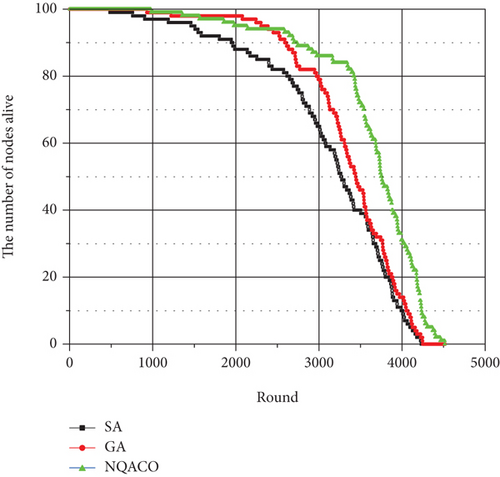
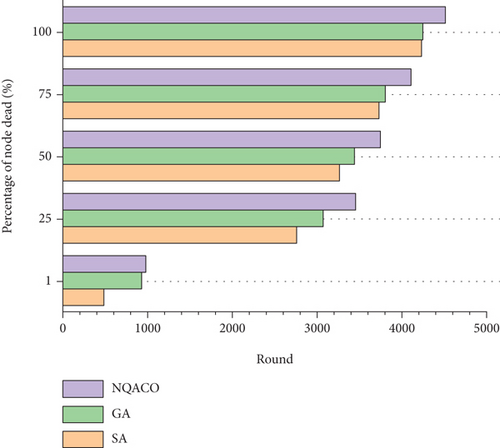
Through the comparative analysis of the above simulation experiments, it can be seen that NQACO introduces the chaos operator, which makes use of the randomness and convenience of chaotic variables so that the individuals in the ant colony can be evenly distributed in the solution space, which significantly enhances the algorithm’s optimality finding ability and prevents NQACO from falling into local optimum prematurely like GA and SA. Meanwhile, the ants in NQACO adopt quantum bit-based coding, which introduces the quantum state vector into the coding of the ant colony algorithm to avoid the phenomenon of premature convergence. Overall, the NQACO proposed in this paper always has better performance in reducing the network’s total energy consumption than GA and SA for the different number of wireless communication nodes.
6. Conclusions
In this paper, a clustering model is proposed to reduce energy consumption and prolong the network lifetime in WAMRN by selecting optimal cluster heads for efficient use of energy. The optimization problem of this model has been shown to be NP-hard, so we propose a new NQACO algorithm to optimize it. Through simulation experiments, the effectiveness and efficiency of the NQACO algorithm in optimizing and reducing the total network energy consumption are verified. The simulation results indicate that our proposed NQACO scheme has lower communication energy consumption than the traditional GA and SA schemes and has more advantages in extending the lifetime of WAMRN.
Additional Points
Additional Information. Correspondence and requests for materials should be addressed to Y.Z.
Conflicts of Interest
The authors declare no competing interests.
Authors’ Contributions
J.L. and Y.Z. conceived and designed the study. J.L. and H.Q. performed the experiments. J.L. and H.Q. wrote the paper. J.L., Y.L., and J.Z. reviewed and edited the manuscript. All authors read and approved the manuscript.
Acknowledgments
This paper was funded by the Major Science and Technology Project of the Eighth Division in Xinjiang (2021ZD002): Study on Key Technologies of Integrated Energy Collaboration Planning and Integrated Operation of PV& Storage Demonstration under the Condition of Independent Power Grid, the Corps Innovative Talents Plan (grant number 2020CB001), the project of Youth and Middle-aged Scientific and Technological Innovation Leading Talents Program of the Corps (grant number 2018CB006), the China Postdoctoral Science Foundation (grant number 220531), the Funding Project for High Level Talents Research in Shihezi University (grant number RCZK2018C38), and the Project of Shihezi University (grant number ZZZC201915B), Postgraduate education innovation program of the Autonomous Region.
Open Research
Data Availability
The datasets generated and analyzed during the current study are available from the corresponding author on reasonable request.




